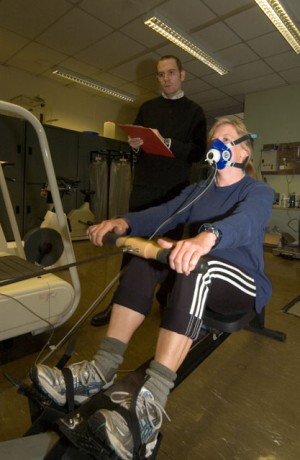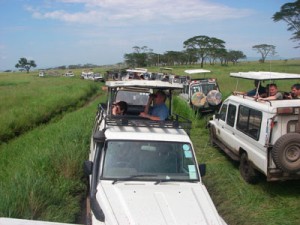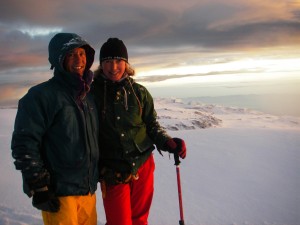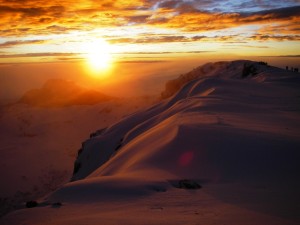
On Monday I was at the Institute of Naval Medicine in Gosport, Hampshire, for physiological testing. This was generously offered to me free of charge as part of the RN's support for my Pacific row. I don't want to sound ungrateful, but I really hate these tests. For most-hated procedure it's a close-run contest between the VO2 max test and bodyfat percentage analysis.
To do the VO2 max, I was rigged up with ECG leads attached to my chest to monitor my heart activity, and a mask was placed over my nose and mouth to analyse the volume and constituents of air inhaled and exhaled.
Then the hard bit - I had to row at a steadily increasing intensity until I reached the absolute maximum of which I was capable. It started out at very light pressure, but after each minute I was instructed to step up the intensity until I was going flat out.
For some reason - possibly the aftermath of climbing Kilimanjaro and/or a long-haul flight, I was feeling physically under par. As soon as I started rowing I felt nauseous. I managed not to throw up into the face mask, but the queasiness was definitely a distraction. I completed the test but the result was not especially impressive. 42 ml/kg/min. For comparison, a rower like James Cracknell would apparently have a max of about 60, while Paula Radcliffe would apparently have a VO2 max of about 70. Blimey.
VO2 max is apparently genetically determined, so I could with training improve my max by 10-20% but little more than that.
My bodyfat percentage on the other hand, is largely cookie-determined, so is capable of significant improvement from its current level of... no, actually, I'm not telling you. I'll put it like this - I'm well famine-proofed.
[Photo: with Jason Lyons at the INM]
|
|

I had an amazing time in Tanzania, but it also raised some disturbing questions.
When I came to Kenya on safari 10 years ago, we could go an entire day and only see one or two other vehicles. The other day when we got wind that there was a leopard basking in a particular tree in the Serengeti, we shared the experience with over 100 other people, with about twenty-five vehicles lining up to see the big cat. There is no regulation of the number of people or vehicles coming into the park.
I wonder when the situation changed, from being bubbles of human settlement surrounded by wildlife, to being bubbles of wildlife surrounded by human settlement. When did we stop trying to keep the animals out of our areas, and start trying to keep them inside theirs?
Another worry - the national park that encompasses Kilimanjaro apparently raised the price of a permit recently, to $120 a day. This has done nothing to reduce the number of people coming into the park. From what I saw, the footpaths are in danger of being eroded - especially on the main route (also known as the Coca Cola route due to its popularity).
How long before these places become victims of their own success, and the 'wilderness experience' becomes as contrived as a Disneyland ride?
|
|
03 Feb 2007

Congratulations to Roz and Eric! Photographed on Kilimanjaro. What an achievement to get to the summit in spite of the rain - and then getting a lovely sunrise. Well done.
|
|

Yesterday morning shortly after 6am local time, I stood on the highest point in Africa and watched the sun rise. It was magical.
It had taken us 6 days of trekking to reach the high camp. Mileage-wise, we could have got there sooner, but we had to allow time for our bodies to adapt to the altitude. The peak of Kilimanjaro is at 5895m (or 19,340ft), where the oxygen content of the air is only half what it is at sea level. Even though the ascent is non-technical, i.e. you don't need crampons, ice axes etc - it's just a (very) stiff hike - the altitude alone makes it a challenge. I found that even though my resting heart rate was around its usual level of 44 beats per minute, as soon as I did anything remotely strenuous it would sky-rocket to 140+. Doing that for any more than 6 hours a day would have been exhausting, leaving me severely depleted even before attempting the summit. So we took it easy.
The first few days of our trek had started out sunny, with the rain starting early afternoon. But after that the rain had come at any and every time of day, making our campsites into squelching quagmires. We didn't have enough sunshine to dry out our clothes from one day to the next, so we had to just dress in whatever was least wet (or least smelly). And this was supposed to be the dry season.
Summit Day started at 11pm on 1st Feb. We got up, packed up, and were out of camp by midnight. The moon was just one sliver shy of a full moon, so we hardly needed our headtorches in the bright moonlight. The reason we started so early (or was it late?!) was in the hope that we would have better weather earlier on in the day. But given the excessive precipitation on the way up, I secretly thought it unlikely that we would have any kind of a view from the summit.
My hopes of favourable weather rose as we toiled up across the famous snows. The clouds parted enough to allow the moon and a number of stars to peek through. One of mental snapshots of the day was the moon shining brightly up ahead of us, shining down into the crater of this dormant volcano, highlighting the contours of the rock and snow below us.
6 hours after we had left our high camp, we arrived at the summit at 6am on 2nd Feb. The sunrise was already brightening the eastern sky. We took the obligatory summit photos, and then, just as we were making ready to start our descent, a sliver of pure red appeared. It grew into one of the most spectacular sunrises I have ever seen. It lasted only 10 minutes before another belt of clouds closed in, but those 10 minutes made the 6 days of muddy slogging worthwhile. It was a moment I will never forget - my moment on the roof of Africa.
|
|